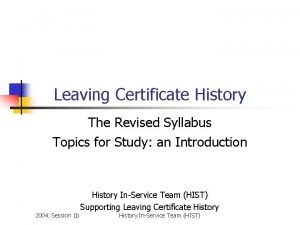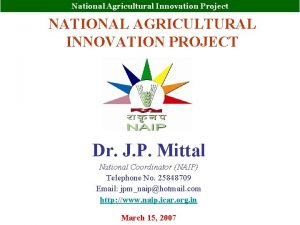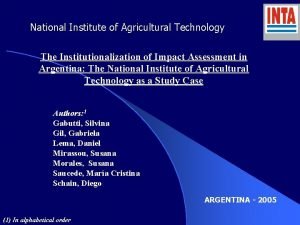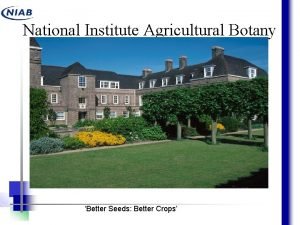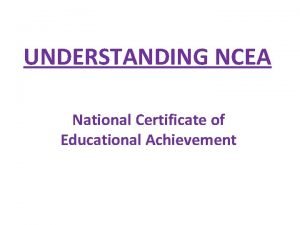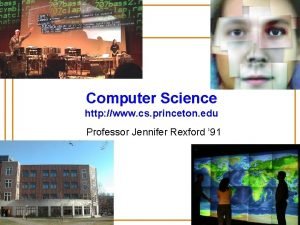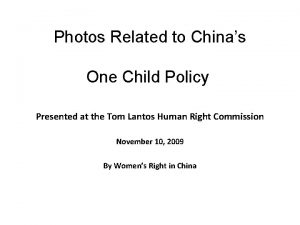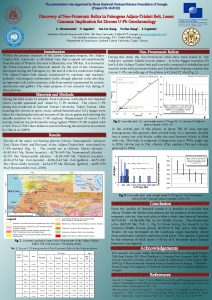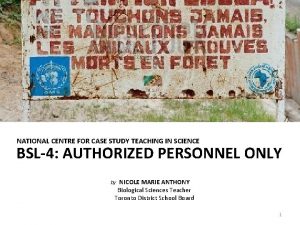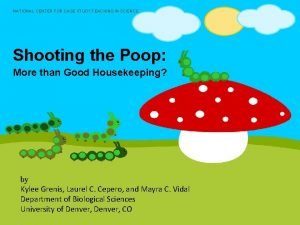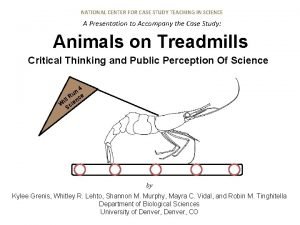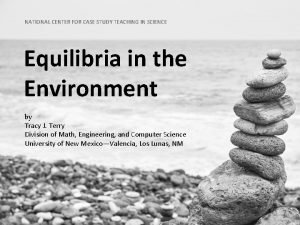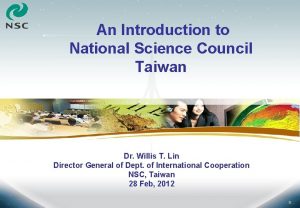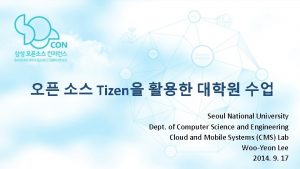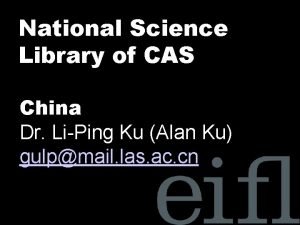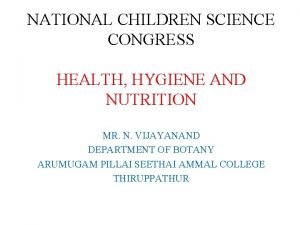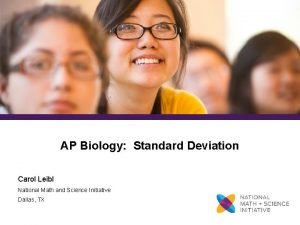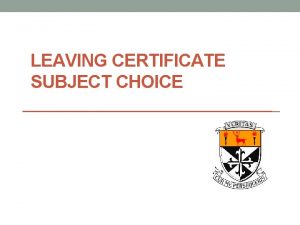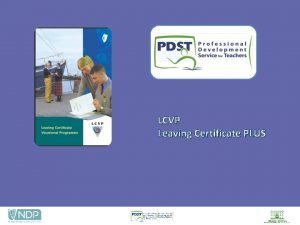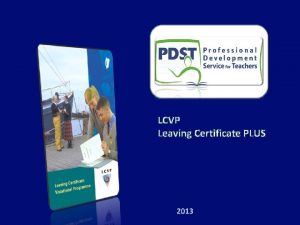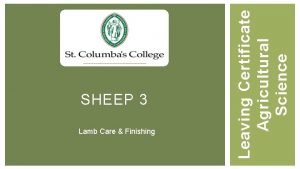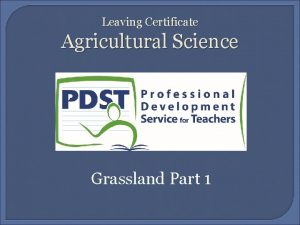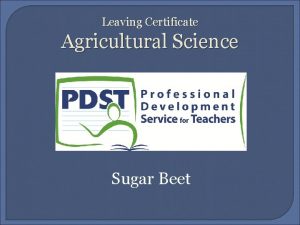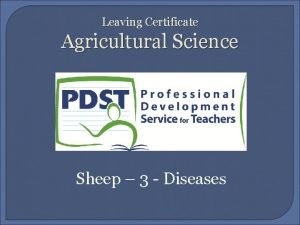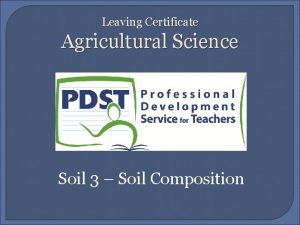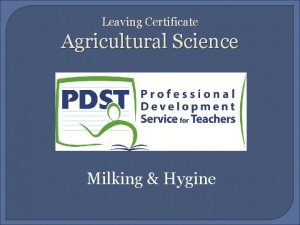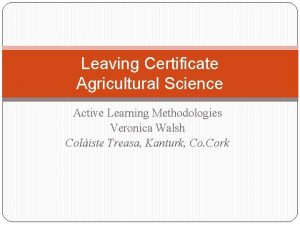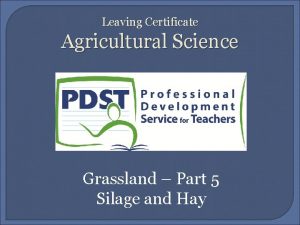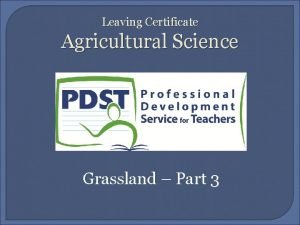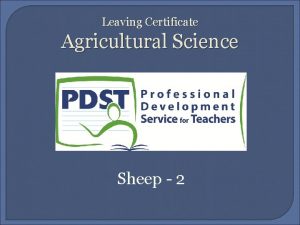Leaving Certificate Agricultural Science National Workshop One 1





































- Slides: 37

Leaving Certificate Agricultural Science National Workshop One 1


Leaving Certificate Agricultural Science Team Michael Domican Michael Quinn Contact Email agscience@pdst. ie

Overview of the Day Session 1 09. 30 -11. 00 -11. 15 Session 2 11. 15 -1. 00 -2. 00 Session 3 2. 00 -3. 30 ● ● ● Supports provided by PDST and the role of the teacher Aims and objectives of new the specification Introduction to the overarching strand crosscutting themes Tea/Coffee ● Introduction and implementation of a student-centred approach Lunch ● ● A student-centred approach to creating a unit of learning Next steps?

Purpose for Today ● To begin to look at the new specification with a focus on student-centred approaches. ● 5 To encourage collaboration in engaging with and implementing the new specification.


Core Professional Development Five National Workshops Five Professional Learning Community Evenings Five Webinars

Supports provided by PDST Supports Seminars 8 Webinars Professional Learning Communities School Visits PDST Website Scoilnet

Professional Learning Communities • • Knowledge created through collaboration Opportunities to build relationships Public sharing of work (central to CPD) Questions that prompt discussion Opportunities to reflect/problem solve Trust Increased self-belief Starts Today! – Melissa Parker, Kevin Patton & Mary O'Sullivan (2016) Borg, 2012

The Role of the PDST What we are: • • Teachers & school leaders Teacher Educators Facilitators / Enablers Purveyors of lifelong learning

Exploring the New Specification Session 1

Key Messages 180 hou rs Higher & minimum dura tion Ordinar y level Septem ber 201 9 in First ex aminatio troduction n Assess ment: W June 2021 ritten Ex Course am 75% Work 25 % Agricultural Science is a subject for all and through its implementation of key skills students, will be prepared and empowered to contribute to society and manage future challenges confidently. Strand 1 is an overarching strand, themes of which permeate all strands of the specification and will be progressively developed over the course of senior cycle. A student-centred approach to teaching and learning cultivates students’ critical thinking skills in agricultural science by encouraging them to ask questions relating to the world around them and apply their learning in differentiated, collaborative, creative and 12 innovative ways.

Exploring the Big Ideas in the New Specification https: //www. curriculumonline. ie/Senior-cycle/Senior-Cycle-Subjects/Agricultural-Science

Top Ten Key Skills in 2020 Senior Cycle Key Skills Complex Problem Solving Critical Thinking Creativity People Management Coordinating with Others Emotional Intelligence Judgement and Decision Making Service Orientation Negotiation Cognitive Flexibility World Economic Forum, 2018 Figure 3 , Specification 2018, Page 13

Structure of the Specification Cross-cutting Themes in Agricultural Science Figure 4, Specification 2018, Page 11

Role of the Classroom Teacher Specification 16 Students

Working with the Structure of Specification Understand how a variety of soil factors influence productivity Describe the different soil types/groups and soil profiles and their distribution in Ireland Sustainability Food Production Apply their knowledge and understanding of Agricultural Science to develop arguments or draw conclusions related to both familiar and unfamiliar situations Design manage and conduct practical investigations Discuss, debate, reflect on and critically evaluate the outcomes of their own and others’ investigations.

Reflecting on Teaching and Learning with the New Specification Placemat Think Pair _____ Square Share hcreate. kahoot. it/share/pdst-ag-science/f 7 ef 85 d 2 -0625 -49 fc-a 075 -be 9 b 410 a 2328 ttps: // Students Anticipation Exercise

Exploring a Student-Centred Approach to Teaching and Learning Session 2

Key Messages Agricultural Science is a subject for all and through its implementation of key skills students, will be prepared and empowered to contribute to society and manage future challenges confidently. Unit 1 is a overarching strand, themes of which permeate all strands of the specification and will be progressively developed over the course of senior cycle. A student-centred approach to teaching and learning cultivates students’ critical thinking skills in agricultural science by encouraging them to ask questions relating to the world around them and apply their learning in differentiated, collaborative, creative and 20 innovative ways.

Exploring Student-Centred Teaching and Learning Through engaging in self-directed activities and reflection, students assume responsibility for planning, monitoring, and evaluating their own learning and, in so doing, develop a positive sense of their own capacity to learn. What does a Student-Centred Approach mean to you? By engaging in group work students develop skills in reasoned argument, listening to each other, informing one another about what they are doing, and reflecting on their own work and that of others. Teaching and Learning, Specification 2018, Page 15. 21

The Roles for this Student-Centred Activity Teacher Specification Students 22

Stimulus BBC Countryfile at BGI ~ Farming Crops for Fuel BIOFUELS https: //www. youtube. com/watch? v=OCQa 1 gctl 68 23

How can I ensure that the operation of my farm will meet food and energy needs in the future? 24

Reflecting on the Process as Learner Through engaging in self-directed activities and reflection, students assume responsibility for planning, monitoring, and evaluating their own learning and, in so doing, develop a positive sense of their own capacity to learn. By engaging in group work students develop skills in reasoned argument, listening to each other, informing one another about what they are doing, and reflecting on their own work and that of others. Teaching Learning, Specification 2018, Page 15 Padlet http: //tinyurl. com/y 7 h 2 gw 3 e 25

Utilising a Student-Centred Approach Resourcing the Inquiry Prior knowledge (Own & Others) Support Materials Internet research Interpreting Information ❖ What information supports my task? ❖ What information is not relevant to my task? ❖ How does the information connect to what I already know? ❖ What else do I need to research? ❖ Other Does this raise new inquiry questions for further exploration? 26 Reporting Findings Classroom Presentation

Reflecting on the Process as Teacher Discuss harvesting techniques and storage methods for an energy crop Describe the growth of an energy crop Discuss the implications of sustainable development for crop production Sustainability How did the selection of these outcomes inform the inquiry as it progressed? How could the cross-cutting themes enrich the activity? Compile and interpret data or other information gathered from print, laboratory, and electronic sources (Including websites), to research a topic or solve a problem 27 Read and evaluate scientific information related to agriculture, drawing on a variety of sources: media, websites, agrifoods events and other agriculture resources – including people involved in the agri-food industry Environment Communicating the procedures and results of investigations by displaying evidence and information in various forms, including flow charts, tables, graphs, and laboratory reports

Student-Centred Approach to Learning 28 https: //www. youtube. com/watch? v=u 84 Zs. S 6 ni. Pc

Developing Student-Centred Approaches for Teaching and Learning Session 3

Key Messages Agricultural Science is a subject for all and through its implementation of key skills students, will be prepared and empowered to contribute to society and manage future challenges confidently. Strand 1 is a overarching strand, themes of which permeate all strands of the specification and will be progressively developed over the course of senior cycle. A student-centred approach to teaching and learning cultivates students’ critical thinking skills in Agricultural Science by encouraging them to ask questions relating to the world around them and apply their learning in differentiated, collaborative, creative and innovative ways. 30

Potential Methodologies to Support Inquiry Placemat Think Pair _____ Square Share 31 Students Anticipation Exercise

Pathways to Engaging with the Specification THEMES Health and Safety Technology 1. Design a Farm – pupils use their knowledge of farm safety to design the ideal farm 2. Design a Safety Poster for Slurry Management on the Farm 3. Mathematical Exercise – study the number of fatalities on farms and the cause – present the results in tabular format/ graphical format 1. Discuss the technologies used on a range of farms e. g. dairy, arable, poultry, horticulture, beef and sheep. Give a short 3 minute presentation on one technology adopted, and the key benefits. 2. Produce a leaflet on one of the listed technologies explaining how it might be used on a farm and the benefits to the farmer. Sustainability 1. Produce a poster showing how traditional farming practices (e. g. crop rotation and rotating grazing livestock) help conserve the soil and vegetation. 2. Explain how using different types (species) of livestock on the same land can help promote soil and vegetation conservation. Environment 1. Suggest why there is often a conflict between productivity and conservation. Rank the farm pollution sources for their respective BOD values, from lowest (least polluting) to highest (most polluting). 2. Prepare a Power. Point detailing possible pollution sources in you local area or local farm. Food Production 32 SUGGESTED RICH LEARNING TASKS 1. In class, conduct a research exercise to investigate how your family or adopted farm could be made more intensive or extensive/organic respectively. 2. Visit an intensive farm e. g. indoor pig production, and an extensive/organic farm e. g. outdoor sheep farming

Develop a Unit of Learning In Collaboration 33 Non-Linear (Selection of learning outcomes) Student – centred Approaches Accessible for all (teaching methodologies, modes of assessment & stimulus materials)

Revisiting the Anticipation Exercise

35

Next Steps? 36

Supports provided by PDST Supports Seminars 37 Webinars Professional Learning Communities School Visits PDST Website Scoilnet
 History syllabus leaving cert
History syllabus leaving cert Primary school leaving examination in chinese
Primary school leaving examination in chinese Clonakiltycc vsware
Clonakiltycc vsware National agricultural innovation project
National agricultural innovation project National institute of agricultural technology
National institute of agricultural technology National institute of agricultural botany
National institute of agricultural botany Mathematics ____ my favorite subject.
Mathematics ____ my favorite subject. National career readiness certificate
National career readiness certificate National certificate of educational achievement
National certificate of educational achievement National certificate of educational achievement
National certificate of educational achievement One god one empire one religion
One god one empire one religion One one one little dog run
One one one little dog run One king one law one faith
One king one law one faith Byzantine definition
Byzantine definition One ford behaviors
One ford behaviors See one do one teach one
See one do one teach one One price policy
One price policy One face one voice one habit and two persons
One face one voice one habit and two persons Studiendekanat uni bonn
Studiendekanat uni bonn One vision one identity one community
One vision one identity one community Asean one vision one identity one community
Asean one vision one identity one community Cs princeton
Cs princeton One-child glory certificate
One-child glory certificate National unification and the national state
National unification and the national state Unist application fee
Unist application fee Shota rustaveli national science foundation
Shota rustaveli national science foundation National centre for case study teaching in science
National centre for case study teaching in science National center for case study teaching in science
National center for case study teaching in science National center for case study teaching in science
National center for case study teaching in science National center for case study teaching in science answers
National center for case study teaching in science answers National science council taiwan
National science council taiwan Seoul national university computer science
Seoul national university computer science Science national honor society project ideas
Science national honor society project ideas National 5 environmental science
National 5 environmental science National science library
National science library National children's science congress projects ideas
National children's science congress projects ideas National 5 engineering science
National 5 engineering science National math and science initiative ap biology
National math and science initiative ap biology
